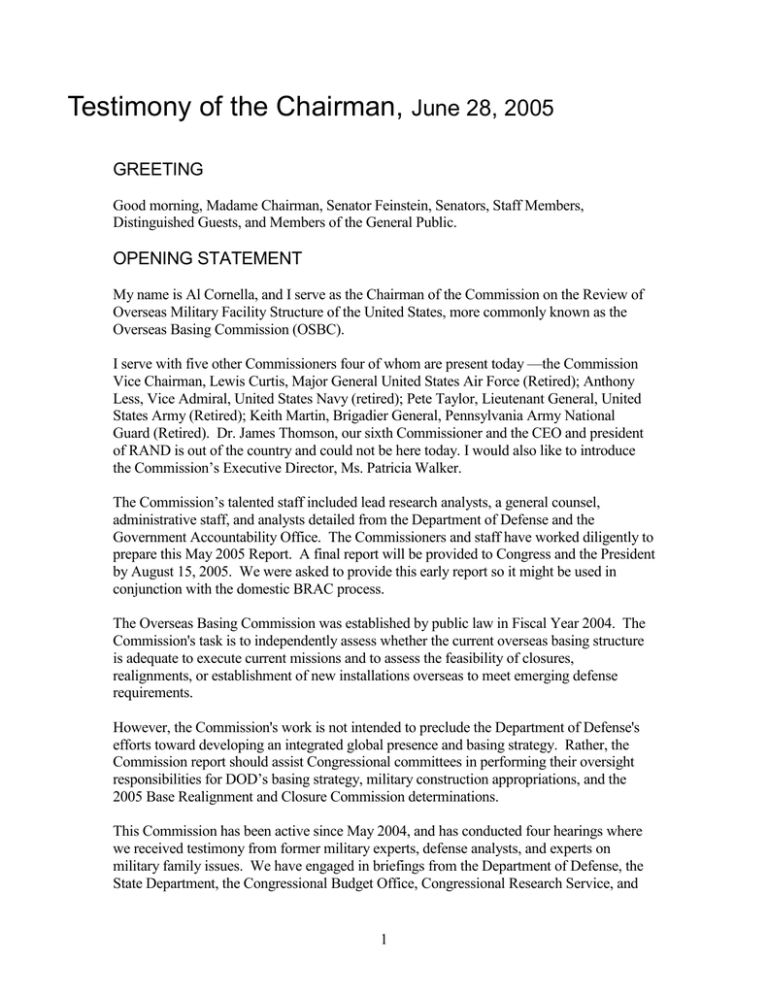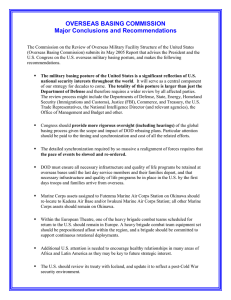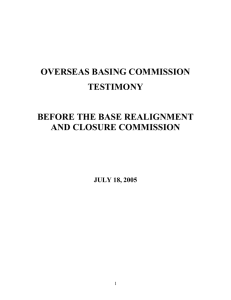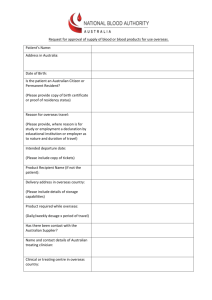Testimony of the Chairman, June 28, 2005 GREETING
advertisement

Testimony of the Chairman, June 28, 2005 GREETING Good morning, Madame Chairman, Senator Feinstein, Senators, Staff Members, Distinguished Guests, and Members of the General Public. OPENING STATEMENT My name is Al Cornella, and I serve as the Chairman of the Commission on the Review of Overseas Military Facility Structure of the United States, more commonly known as the Overseas Basing Commission (OSBC). I serve with five other Commissioners four of whom are present today —the Commission Vice Chairman, Lewis Curtis, Major General United States Air Force (Retired); Anthony Less, Vice Admiral, United States Navy (retired); Pete Taylor, Lieutenant General, United States Army (Retired); Keith Martin, Brigadier General, Pennsylvania Army National Guard (Retired). Dr. James Thomson, our sixth Commissioner and the CEO and president of RAND is out of the country and could not be here today. I would also like to introduce the Commission’s Executive Director, Ms. Patricia Walker. The Commission’s talented staff included lead research analysts, a general counsel, administrative staff, and analysts detailed from the Department of Defense and the Government Accountability Office. The Commissioners and staff have worked diligently to prepare this May 2005 Report. A final report will be provided to Congress and the President by August 15, 2005. We were asked to provide this early report so it might be used in conjunction with the domestic BRAC process. The Overseas Basing Commission was established by public law in Fiscal Year 2004. The Commission's task is to independently assess whether the current overseas basing structure is adequate to execute current missions and to assess the feasibility of closures, realignments, or establishment of new installations overseas to meet emerging defense requirements. However, the Commission's work is not intended to preclude the Department of Defense's efforts toward developing an integrated global presence and basing strategy. Rather, the Commission report should assist Congressional committees in performing their oversight responsibilities for DOD’s basing strategy, military construction appropriations, and the 2005 Base Realignment and Closure Commission determinations. This Commission has been active since May 2004, and has conducted four hearings where we received testimony from former military experts, defense analysts, and experts on military family issues. We have engaged in briefings from the Department of Defense, the State Department, the Congressional Budget Office, Congressional Research Service, and 1 other entities. The Commission has met with commanders and received extensive briefings on the transformation plan for the European Command, Pacific Command, and Central Command. The Commission has also met with the Transportation Command, Special Operations Command, and Southern Command. The majority of our time was dedicated to the areas of greatest change. MAIN TESTIMONY Congress created the Overseas Basing Commission as an independent, unbiased entity to produce a Report that advises Congress on the current and future overseas basing structure of U.S. military forces. This is truly a daunting task. In order to explain the preliminary conclusions and recommendations that the Commission is prepared to offer to this Committee today, let me begin by explaining the analytic approach we took examining and thoroughly studying various important aspects of the overseas basing structure. ANALYTIC APPROACH First, the Commission began with a thorough analysis of national security, defense, and military strategies. The Commission completed a careful review of the foundation document for global reposturing, the 2004 Department of Defense Integrated Global Presence and Basing Strategy (IGPBS). Second, based on the Commission’s interviews of key officials in the Office of the Secretary of Defense, the Joint Staff, the COCOMs, U.S. Transportation Command, and the State Department, the Commission developed evaluation criteria to assess how effectively the current and future overseas basing postures support current and future national security and military operations. In addition, the commission consulted with former senior military leaders and other national security experts. Commissioners and staff participated in six overseas trips to various commands. We conducted four public hearings where we received testimony from former military experts, defense analysts, and experts on military family issues. At the final hearing we had Mr. Doug Feith and Vice Admiral Robert F. Willard from the Department of Defense and Ambassador Rose Likens as a representative of the State Department. We have engaged in briefings from the Department of Defense, the State Department, the Congressional Budget Office, Congressional Research Service, and other entities. We visited military installations in many countries, meeting with U.S. Forces, embassy representatives, foreign military officers, and local officials. We have met with the majority of Combatant Commands and in most cases with the commanders and their staffs. The Commissioners have received briefings from US Central Command, US Southern Command, US Special Operations Command and US Transportation Command. We have made two trips to the Pacific Command, three to the European Command, and one to the 2 Central Command. All the Commissioners, and I, have learned a great deal from these discussions, both here and abroad. Finally, based on its review and analysis, the Commission identified six major areas of concern: Geopolitical Considerations; Timing and Synchronization; Operational Requirements; Mobility; Quality of Life; and, Costs I will briefly address each area of concern, and explain the findings and conclusions of the Commission on each issue. GEOPOLITICAL CONSIDERATIONS The Commission has determined that the DOD’s IGPBS does not adequately address current and future geopolitical and strategic needs in response to existing and emerging security threats for two reasons. First, it is the view of the Commission that the IGPBS is too narrowly based on military concerns. While the Commission wishes to commend the Department of Defense on the design of IGPBS—which is a strategy that is directly aimed at addressing the matrix of existing and emerging threats—it is clear that the IGPBS has been almost exclusively designed by and for the military. In the present era of a global war on terror and the indisputable global competition in defense, intelligence, diplomacy, commerce and energy matters, the Commission feels that it would be wise to broaden the underlying assumptions, scope and participation in the IGPBS process to include vital players involved in other areas of our national security. The interagency process might, for example, include the Departments of Defense, State, Energy, Homeland Security (especially Immigration and Customs and Border Patrol), Justice (especially the Federal Bureau of Investigation), Commerce, and Treasury, the National Intelligence Director, and others. After completing the interim report, we were advised that we are the fourth commission to come to this conclusion. (Others are 9-11, Intelligence, and Roles and Missions Commissions) The basic concept of the IGPBS—as established by DOD—is fundamentally strong, and can be further refined to include issues related to homeland security, law enforcement, energy, non-proliferation, and other pressing national needs and priorities. Information 3 sharing and inter-agency coordination among government agencies is a top priority of this Administration, and we feel that IGPBS can support this goal by broadening and diversifying its approach and implementation. Indeed, many of our overseas basing capabilities rest on contingencies such as future political relations with bilateral partners fully negotiated and ratified legal agreements that support those bilateral relations. In many cases, the Status of Forces Agreements (SOFA), access agreements, Article 98 agreements, and other legal agreements are not in place in proposed new locations. TIMING AND SYNCHRONIZATION Another reason the Commission feels that the IGPBS should be modified relates to more particular matters of the proposed timing and synchronization of IGPBS. The Commission has concluded that while the IGPBS is an ambitious plan to restructure our global posture, it does so without fully taking into account other dynamic, ongoing and, in some cases, unpredictable changes. If the IGPBS is based on the 2001 Quadrennial Defense Review (QDR), why would you not wait for the results of the current 2005 QDR—scheduled to be completed this fall—or the 2005 Mobility Capabilities Study (MCS) to be completed in August before announcing movements of forces? The simultaneous activities of service transformation, Army modularity, Operation Enduring Freedom, Operation Iraqi Freedom, the Global War on Terrorism, IGPBS, BRAC, resetting the forces, and rebuilding of pre-positioned equipment sets all compete for funding within a limited budget. Not to mention the stress on forces. The current schedule of IGPBS moves will adversely impact the Services ability to adequately fund modernization and readiness. OPERATIONAL REQUIREMENTS The commission is concerned that heavy forces in Europe are being removed from the mix. We also note the strategic importance of Okinawa. Diminishing our capabilities on the island would pose risk to our allies and our national interests in the region. At the same time, we feel it is important to move from Futenma Marine Corps Air Station. Moreover, not enough attention has been given to our ability to train and exercise the force in the formulation of the overseas basing plan. Infrastructure is sparse in some regions and, capabilities for integrated training across services and with allies remain sketchy. The Commission notes with concern that the impact on recruiting and retention by IGPBS rotational forces has not been adequately evaluated, nor have associated risks to 4 sustaining the volunteer force been assessed. We strongly recommend that this be given priority, and that the necessary assessments be completed as quickly as possible. MOBILITY It is clear that the mobility of our military forces is being compromised by the current strains on strategic lift, intra-theater lift, and sealift capabilities. The stress on strategic lift capabilities is being caused, in large part, by our on-going military operations in Afghanistan and Iraq. However, other tactical lift demands in terms of responding to political crises such as in Haiti and Sudan, as well as unanticipated natural disasters necessitating military intervention such as in the recent December 2004 tsunami event, also play a factor in challenging DOD’s mobility capabilities. While moving troops back to the U.S. may be a political priority, force projection demands can only be met by developing a rebasing strategy in coordination with strategic U.S. alliances abroad (both existing and future). Strategic and Intra-theater air and sealift mobility capabilities must be significantly upgraded. We have yet to meet the lift capabilities identified by the Mobility Requirements Study 2005 (conducted in the year 2000). In addition, announcements of global reposturing are being made before the presently ongoing Mobility Capabilities Study (MCS) is concluded. It would seem prudent to wait for the results of that study. Strategic mobility is the key to our ability to respond to events worldwide. Plans for sea and airlift capabilities, as well as prepositioned equipment sets, must take into account the additional demands that IGPBS could place on an increasingly continental United States (CONUS)-based force. Surging forces from CONUS will be problematic if strategic and tactical lift capabilities and prepositioned stocks are not in place. QUALITY OF LIFE Next, I would like to turn to quality of life issues. These issues are complex but are also key concerns of the global positioning strategy, primarily because the U.S. relies on an all-volunteer force. In order to sustain the military force (both in numbers and in strength), the expectations of military personnel and their families with regard to active and reserve duty as well as redeployments must be met. If these expectations are not adequately met, then the U.S. military risks being severely compromised. Needless to say, this has enormous consequences politically and in terms of maintaining national security. We have a moral obligation to our men and women in uniform—and to their families—to provide the quality of life support they deserve. Returning forces and families should have housing, schools for their children, and adequate medical facilities in place before they return and the same should be maintained abroad until the last service member 5 departs. The commission calls this a “last-day, first-day” approach. Not only does this have moral implications, but will also be reflected in retention rates. COSTS Now, with regard to the cost of changing the overseas basing structure and the realignment and closure of bases in general, the Commission recognizes that the costs are significant. In many cases, it is not even possible to predict the true costs of certain strategic changes. The cost of IGPBS is estimated at 8 to 12 billion dollars. An independent analysis for the commission put the figure closer to 20 billion dollars. Many costs are sunk into projected host nation support that may not come to fruition. In other cases, the services are expected to pay from within their service budgets. For example, costs need to be estimated and planned for troop and base relocations. Significant upgrades of main operating bases, forward operating sites, cooperative security locations, and pre-positioned combat support sites need to be planned. Let us also not lose sight of the fact that significant financial investments in new weapons systems, strategic lift capabilities, training, and integrated systems need to be made in order to keep the U.S. military as the premier fighting force in the world. Finally, these changes need to keep abreast of making Quality of Life expenditures in order to attract and keep a dedicated military force. Investing in the training of our military force is also a vital component of maintaining strategic capability, and requires the expenditure of enormous funds. In light of this, the Commission recognizes that Congress should be informed of realistic costs as to coordinate strategic and operational requirements with budgetary needs and constraints. The Congress needs accurate estimates to determine what is prudent, and must be prepared to support IGPBS if it is to succeed. Therefore, in light of the previously mentioned concerns, the Commission makes the following recommendations: The detailed synchronization required by so massive a realignment of forces requires that the pace of events be slowed and reordered. We know of no nation asking us to leave. These moves should be conducted at a pace that does not place additional stress on our armed forces. That the entire effort of overseas basing be integrated into one overarching design that is coordinated and synchronized with all ongoing initiatives. Furthermore, an interagency review process is put in place to periodically 6 consider the impacts of the global force posture and to ensure that outcomes are consistent with overall national interests. The Commission believes strongly that Congressional oversight of the global posture review is truly necessary. The Congress, including the Armed Services and Foreign Relations Committees, should provide more rigorous oversight (to include hearings) of the global basing process given the scope and cost of the DOD rebasing plans, their impacts on the individual services, the men and women of our armed services and their families, and to the political and trade alliances of the United States. Particular attention should also be paid to the timing and synchronization and cost of all the related efforts. DOD must ensure that all necessary infrastructure and quality of life programs (such as housing, medical, schools, etc.) are retained at overseas bases until the last day the service members and their families depart. At the same time, Congress must ensure that the necessary infrastructure and quality of life programs are already in place by the first day the first troops and families arrive from their overseas locations Moreover, the Commission strongly urges that the planned overseas basing structure be coordinated with strategic lift considerations, especially with regard to troop and equipment mobilization. We feel that this planning is necessary in terms of adequately meeting the demands of the overall global pre-positioning strategy Additionally, the Commission recommends that: Marine Corps air assets assigned to Futenma Marine Corps Air Station on Okinawa should relocate to Kadena Air Base and/or Iwakuni Marine Corps Air Station; all other Marine Corps assets should remain on Okinawa. In order to hedge against uncertainty in regard to near term threats, demonstrate a continued and enduring commitment to NATO, and allow for heavy force military to military contacts with our NATO allies, at least one of the heavy brigade combat teams scheduled for return to the United States should remain in Europe fully manned until: 1) The Balkan’s support mission is lifted; 2) a ground-based offensive tank killing system is stationed in Europe; and 3) Operation Iraqi Freedom is mitigated. Additionally, a heavy brigade combat team equipment set should be pre-positioned afloat in the region. These recommendations are in addition to the current DOD plan for a Stryker Brigade in Germany and the 173rd Airborne Brigade in Vicenza, Italy. 7 Further, there should be a commitment to support continuous rotational deployments to Eastern Europe and provide U.S. military-to-military presence in the new NATO countries. The U.S should review its treaty with Iceland, and update it to reflect the post-Cold War security environment. Greater depth is needed in Africa to secure long term U.S. interests against potential competitors. The Horn of Africa initiative should be replicated in those locations elsewhere on the African Continent that may prove to be of increasing importance to future strategic concerns. To some extent, similar initiatives are needed in Latin America. FINAL REMARKS As a final note, I wish to thank the members of this committee for inviting the commission to appear today. It has been my privilege to describe the work of the Commission to date, and to express its preliminary recommendations. Of course, the Report has not been finalized, and it is my hope that this will be the beginning of a dialogue in this matter so that the Commission can strengthen its analysis, conclusions and recommendations before submitting its final Report on August 15, 2005. Please be assured that the Commission and staff are open to the views and concerns of Congress. Thank you for giving us this opportunity to serve the needs of the Congress and of the nation, and we will be happy to answer any questions that you may have at this time. 8 OVERSEAS BASING COMMISSION TESTIMONY BEFORE THE SENATE APPROPRIATIONS SUBCOMMITTEE ON MILITARY CONSTRUCTION AND VETERANS AFFAIRS JUNE 28, 2005 9




